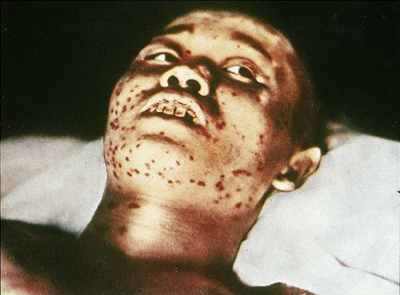
The amount of absorbed radiation was sufficient to destroy the blood elements that control bleeding. The bleeding into the skin to the degree shown in the photograph represents bleeding within all the internal organs of the body, thereby indicating this was a sign of a terminal event.

Radiation Effects
A 21-year-old soldier was at a wooden building of Unit No. 104, 1 kilometer northeast of the Nagasaki hypocenter. His back, right elbow and right abdomen were slashed. On August 18, while receiving treatment, he finds his hair is falling out. On August 29, his gums bleed and purple spots of hypodermal bleeding appear. He has to be hospitalized on August 30, and develops fever the following day. On September 1, his left tonsil swells, and the pain in his throat makes it difficult to swallow. Bleeding does not stop, and spots of hypodermal extravasation appear all over his face and upper part of his body. On September 2, he loses consciousness and is delirious. He dies at 9:30 p.m. on the following day at the Ujina Branch of the First Army Hospital. Photographed two hours before he dies on September 3. Photograph by Kenichi Kimura (U.S. returned materials).